Page 13 of 22
Re: CRINCH! The Crab of the Day!
Posted: Mon Oct 03, 2016 10:13 pm
by Nezumiiro
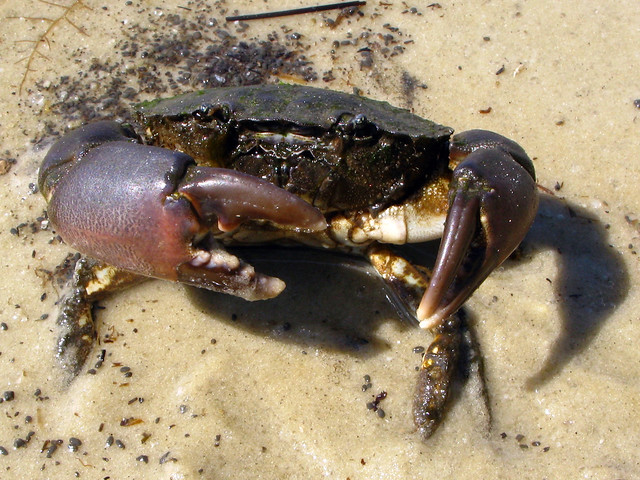
Photo credit:
Alan CresslerCRINCH! #CrabOfTheDay for 10/03/2016: Panopeus obesus, or The Salt Marsh Mud Crab is a Gulf of Mexico/Western Atlantic, family Panopeidae species of mud crab known for their maroon carapace, and STRONG, knobby claws. This 'Smith, 1869' crab is a relatively common intertidal species- even occupying a fairly broad segment of the regional fossil record. Being perfectly adapted to prying open shellfish with their beefy claws, it's no wonder that these crabs sneak their way into oyster and muscle farms.
Taxonomically speaking, “Panopeus” (Πανοπεύς) was an ancient Greek town, near the frontier of Boeotia.
http://www.marinespecies.org/aphia.php? ... &id=422085 http://www.eol.org/pages/313348/overview
Re: CRINCH! The Crab of the Day!
Posted: Tue Oct 04, 2016 3:01 pm
by Nezumiiro
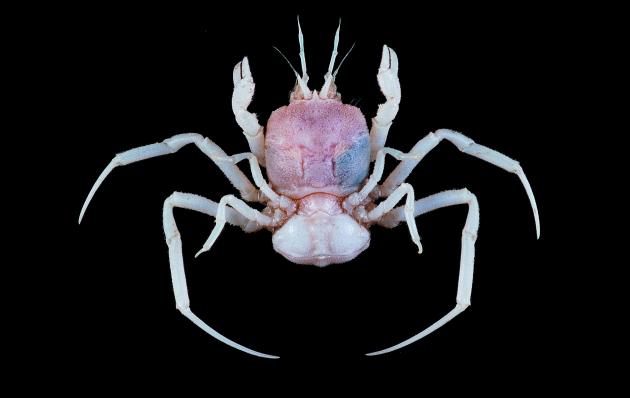
Photo credit:
Tin-Yam ChanCRINCH! #CrabOfTheDay for 10/03/2016: Cymonomus andamanicus, or The Silk-Footed Crab (in Chinese: 安達曼絲足蟹) is a flat out bizarre looking family Cymonomidae “crab” can be found primarily in the Andaman Sea, South China, and Japan. Possessing oddly segmented antennae spines, LARGE carapace peripods but small thoracic legs, and a lumpy ‘tail’ that cannot really be folded- this crustacean is one hot mess! Living in the mud at the 250 m -1150 m depth zone, C. andamanicus is a rare and poorly understood species.
http://www.marinespecies.org/aphia.php/ ... &id=440011http://species-identification.org/speci ... ndamanicus
Re: CRINCH! The Crab of the Day!
Posted: Thu Oct 06, 2016 1:27 am
by Nezumiiro
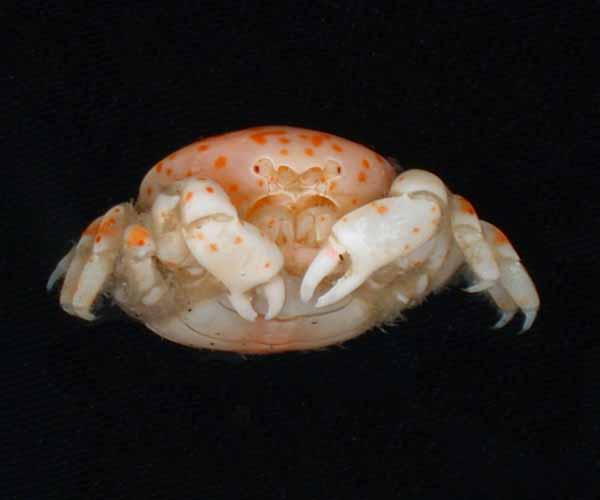
Photo credit:
The Southeastern Regional Taxonomic Center: SERTCCRINCH! #CrabOfTheDay for 10/05/2016: Pinnaxodes floridensis, or The Polka-Dot Pea Crab is a GROSS parasitic pinnotherid crab, endemic to the Northern part of the Gulf of Mexico. Found living in the cloaca and respiratory tree of the Holothurian, (Sea Cucumber) Theelothuria princeps, and juvenile crabs can also be found in the holothurian digestive tract. The bright-red mottled polka-dots on this crab’s carapace are caused in large-part by a second-hand diet of carotenoid rich mud.
http://www.marinespecies.org/aphia.php? ... &id=422159http://www.itis.gov/servlet/SingleRpt/S ... alue=99027
Re: CRINCH! The Crab of the Day!
Posted: Fri Oct 07, 2016 12:16 am
by Nezumiiro
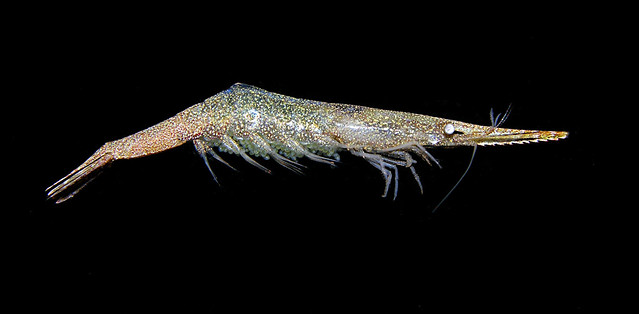
Photo credit:
Arthur AnkerCRINCH! #CrabOfTheDay for 10/06/2016: The Seagrass Arrow Shrimp, or Tozeuma carolinense is a FREAKY family Hippolytidae cleaner shrimp, found in the West Atlantic, Gulf of Mexico, Costa Rica and Panama. This tropical shrimp is typically found on rocky bottoms and seagrass beds in intertidal areas, where it uses its distinct body shape and ability to swim in the vertical position to camouflage itself among the individual seagrass blades. Cool.
Photo credit: North American Native Fishes Association, NANFA
http://www.marinespecies.org/aphia.php? ... &id=421784http://www.eol.org/pages/343553/overview
Re: CRINCH! The Crab of the Day!
Posted: Fri Oct 07, 2016 11:27 pm
by Nezumiiro

Photo credit:
Nicky vBCRINCH! #CrabOfTheDay for 10/07/2016: Diogenes extricatus, or The Common Sand Hermit is a classic and commonly found family Diogenidae Hermit Crab. Native to Africa, The Indian Ocean, and parts of Middle Asia, this rather average crab has a sickly pale-green color, bristly setae, and a oblong oval left claw- used to seal the shell when the crab withdraws. These crabs will use whatever gastropod shells they can find to protect their soft-skinned abdomens, often fighting off other hermits for them! First catalogued by British zoologist Thomas Roscoe Rede Stebbing in 1910, the distinction of D. extricates and over 100 other species earned Stebbing Linnean Society Fellowship and Royal Society Membership.
http://www.marinespecies.org/aphia.php? ... &id=246522http://www.gbif.org/species/5716757/
Re: CRINCH! The Crab of the Day!
Posted: Sun Oct 09, 2016 1:49 pm
by Nezumiiro
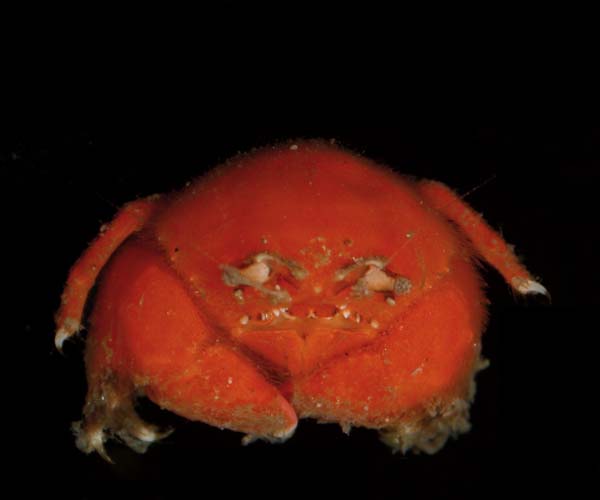
Photo credit:
The Southeastern Regional Taxonomic Center, SERTCCRINCH! #CrabOfTheDay for 10/09/2016: Cryptodromiopsis antillensis, or The Hairy Sponge Crab is a CUTE family Dromiidae ‘carrier crab’ specially adapted to carrying large bits of sponge around as means of camouflage. Using its specialized last pair of walking legs to grasp chunks of sponge, C. antillensis also has a bushy covering of setae, giving it a humorous ‘Santa Claus” appearance. Hailing from Western Atlantic tropical and subtropical waters such as those surrounding the Bahamas and the Bimini Islands, these Brachyuran 'true crabs' are also prized by reef aquarium enthusiasts for having a less destructive temperament than most other carrying crabs.
http://eol.org/pages/1019397/overviewhttp://www.itis.gov/servlet/SingleRpt/S ... lue=621718
Re: CRINCH! The Crab of the Day!
Posted: Mon Oct 10, 2016 10:33 pm
by Nezumiiro
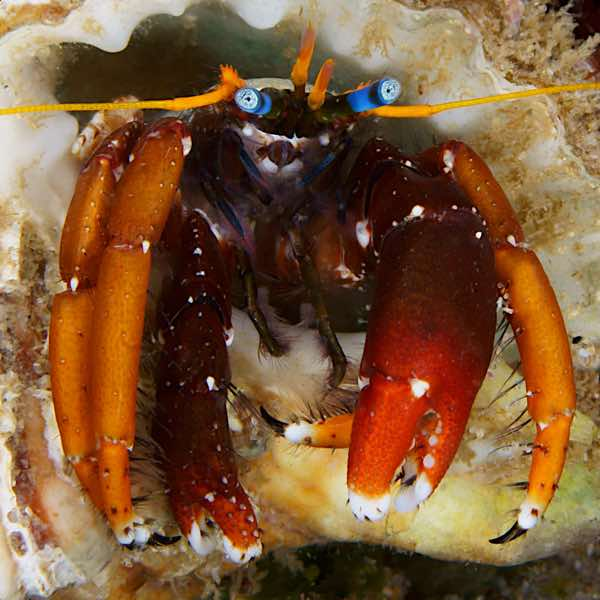
Photo credit:
Denis RiekCRINCH! #CrabOfTheDay for 10/10/2016: Morgan's Hermit Crab, or Calcinus morgani is an African/Indo-Pacific species of Hermit known for its RIDICULOUSLY bright blue eyes! This popular family Diogenidae species is associated with corals but not by evolution, rather- by circumstance. (Facultative adaptivity!) Hanging out in shallow reefs and tidepools, this curious little crab often rides flotsam to foreign waters, only to be just as successful as it is at home!
http://www.marinespecies.org/aphia.php? ... &id=367449http://eol.org/pages/3109897/overview
Re: CRINCH! The Crab of the Day!
Posted: Wed Oct 12, 2016 10:08 pm
by Nezumiiro

Photo credit:
J. PoupinCRINCH! #CrabOfTheDay for 10/11/2016: Nemausa acuticornis, or The Sharphorn Clinging Crab is a West Atlantic/Gulf of Mexico family Mithrax (Mithracidae) species. This rubble-crawling crab inhabits a variety of depths, and is occasionally pulled up in trawling nets near the shores in southern Florida. Named for the SHARP! (Duh!) spines this guy has growing out of the top of his melon; N. acuticornis doesn’t actually grow ‘em until well into adulthood! In juvenile/zoeal stages, Sharphorns are virtually indistinguishable from their cousin species D. spinosissimus are close to Nemausa acuticornis and N. cornuta.
http://www.marinespecies.org/aphia.php? ... &id=421996http://eol.org/pages/1025397/overview
Re: CRINCH! The Crab of the Day!
Posted: Wed Oct 12, 2016 10:15 pm
by Nezumiiro

Photo credit:
Shawn MillerCRINCH! #CrabOfTheDay for 10/12/2016: Uca arcuata, or The Bowed Fiddler Crab is a South Indo-Pacific/New Caledonian Zone inland crab. Frequenting mudflats, river basins, and inland seas, this fiddler is one of the BEST examples of the extremes of sexual dimorphism present in Genus Uca crabs. Males have MASSIVE claws which they use for purposes of mate attraction and sexual competition. Despite being able to regrow these oversized nippers, they are on the whole pretty ineffective for doing other 'crab stuff;' Males can only use their smaller off-claw for eating or burrowing! Oddly enough, when building nesting burrows, some Bowed Fiddlers include a chimney-like structure. The purpose of this structure is unknown, though Chimneys were more often found with burrows of females than with those of males. Weirdly enough, males who built chimney burrows are found to be LESS-LIKELY to attract mates. Because individual crabs compete for burrows, the function of chimney construction may be to decrease the likelihood that an individual loses its burrow to an opponent. Strange!
Fun Fact: These crabs are frequently featured on stamps in China and Southeast Asia, and are also the 'secret ingredient' in some pretty fantastic calligraphy ink! (Check out my link below!)
http://www.marinespecies.org/aphia.php? ... &id=444999http://species-identification.org/speci ... an&id=1761http://www.penaddict.com/blog/2016/7/8/ ... k-a-review
Re: CRINCH! The Crab of the Day!
Posted: Fri Oct 14, 2016 11:39 pm
by Nezumiiro

Photo credit:
Arne KuilmanCRINCH! #CrabOfTheDay for 10/14/2016: Hyastenus bispinosus, or The Hydroid Decorator Crab is a species of Arrow/Neck Crab in the family Epialtidae, found around Ambon, the Banda Islands, Timor and the Lembeh Strait off Sulawesi. These crabs live their lives clinging to hydroids and gorgonians , (Such as Aglaophenia cupressina!) occasionally choosing to attach living parts of the hydroid to themselves for both camouflage and defense. A commensal relationship exist between the H. bispinosus and a hydroid it chooses to live in.
http://www.marinespecies.org/aphia.php? ... &id=441555http://eol.org/pages/4266178/overview
Re: CRINCH! The Crab of the Day!
Posted: Sun Oct 16, 2016 1:04 am
by Nezumiiro

Photo credit:
Rokus GroeneveldCRINCH! #CrabOfTheDay for 10/15/2016: The White-spotted Hermit Crab (Dardanus megistos) is a large, (up to baseball size!) hermit crab with hairy red legs covered with its namesake white spots. Found living in reefs in the Indo-Pacific region from Africa to the South China Sea and Hawaii, this carnivorous is HIGHLY DESTRUCTIVE TO REEF AQUARIUMS! Seriously, D. megistos will jack up fish, snails, scallops, corals, and even other crabs and shrimp! So add this family Diogenidae monster to your tank at your own peril!
http://www.marinespecies.org/aphia.php? ... &id=208700http://www.eol.org/pages/313431/overview
Re: CRINCH! The Crab of the Day!
Posted: Sun Oct 16, 2016 5:43 pm
by Nezumiiro
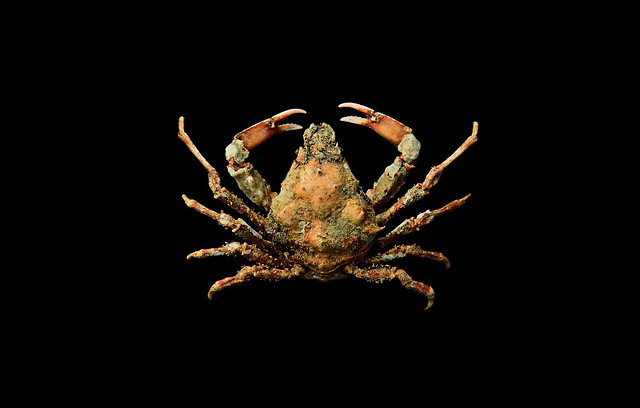
Photo credit:
LonmeloCRINCH! #CrabOfTheDay for 10/16/2016: Scyra compressipes, called the Hiratsunogani (ヒラツノガニ) in Japan is an Asiatic Family Epialtidae species of ‘Horned Clinging Crab.’ This Stimpson-cataloged crustacean has the classic spikey piriform triangular shape with claws broader and longer than its walking legs. Typically seen off the coasts of Japan, China, and South Korea, this crab is named for the Fuji Hiratsuno style of Japanese lacquered Samurai Armor, typically found with horned helmets. (Check out the last link!)
http://www.marinespecies.org/aphia.php? ... &id=441699http://species-identification.org/speci ... mpressipeshttp://www.samurai-store.com/store/prod ... uno-armor/
Re: CRINCH! The Crab of the Day!
Posted: Mon Oct 17, 2016 11:57 pm
by Nezumiiro
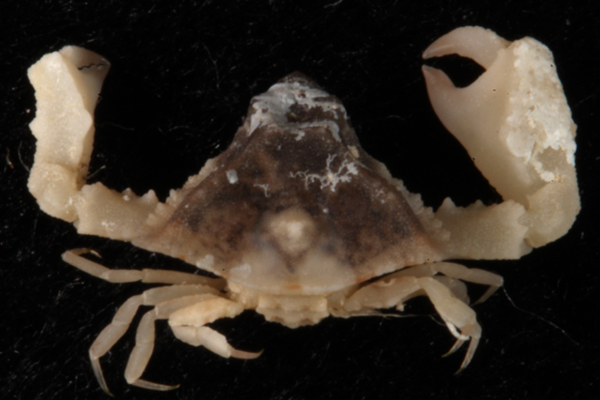
Photo credit:
J. Poupin
CRINCH! #CrabOfTheDay for 10/17/2016: Celatopesia concave, (formerly Cryptopodia concave) or The Corner Crab is a Family Parthenopidae “Buckler Crab, found in the Western Atlantic Ocean, Gulf of Mexico, and Caribbean. This marine muckdweller can be found in a diverse range of depths; from < 1m tidepools to 210+ m. The ridiculously strong chelipeds and incredibly armored main body found on C. concave ensure that it can hold its own against much larger potential predators. On its home turf, a meal of Corner Crab doesn’t come easy!
Funfact: In 1998, the two American species, C. concava and C. hassleri were redescribed and transferred to a new genus, “Celatopesia,” distinguished from their prior genus, Cryptopodia.
http://www.marinespecies.org/aphia.php? ... &id=422023https://inpn2.mnhn.fr/espece/cd_nom/711377?lg=en
Re: CRINCH! The Crab of the Day!
Posted: Tue Oct 18, 2016 5:07 pm
by Nezumiiro

Photo credit:
Southeastern Regional Taxonomic Center (SERTC)CRINCH! #CrabOfTheDay for 10/18/2016: Hypoconcha parasitica, or The Rough Shellback Crab is another of those strange family Dromiidae carrier crabs, found in the Western Atlantic Ocean. This shallow water dweller has fourth and fifth walking legs that are heavily modified to secure a bivalve shell on their back for protection. They can bear a fragment or a whole shell that is larger than their body size. Perhaps aided by pressure of its body against the shell, H. parasitica crabs cling so tightly that removal from the shell without crushing it is almost impossible. When walking on the beach during low tide looking for shells to add to your collection you may find a Hypoconcha crab nestled under an old clam shell!
Oddly enough, females of this species seem to prefer irregularly shaped clam/scallop shells.
http://www.marinespecies.org/aphia.php? ... &id=421892http://eol.org/data_objects/31617279
Re: CRINCH! The Crab of the Day!
Posted: Sat Oct 22, 2016 5:07 pm
by Nezumiiro

Photo credit:
J. Poupin & CorbariCRINCH! #CrabOfTheDay for 10/20/2016: Pagurus brevidactylus, or The Shortfinger Hermit Crab is a distinct hermit found in the Gulf of Mexico and Eastern coasts of the Americas with outlying populations cropping up off the coast of Brazil. These small nocturnal crabs typically eat coral mucus and other detritus on the bipinnate sea plumes and gorgonians they make their home on. As an additionl means of camouflage, P. brevidactylus will affix sand grains and small rocks on its shell.
http://www.marinespecies.org/aphia.php? ... &id=366662http://eol.org/pages/345036/overview
Re: CRINCH! The Crab of the Day!
Posted: Sat Oct 22, 2016 5:09 pm
by Nezumiiro
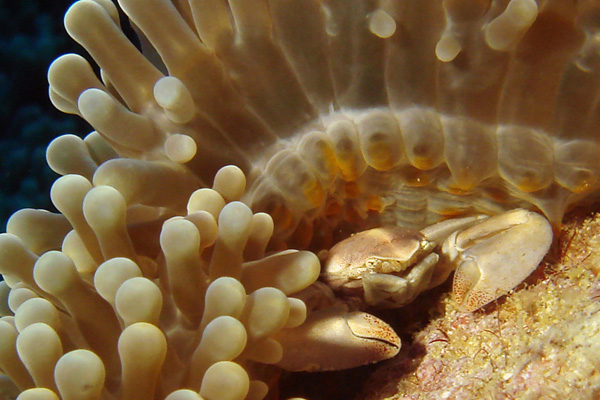
Photo credit:
J. BarraultCRINCH! #CrabOfTheDay for 10/21/2016: Neopetrolisthes spinatus, or Spiny anemone Crab is an Indo-Pacific through New Caledonian Exclusive Economic Zone symbiotic crab, only fairly recently catalogued (2001) formally by Osawa & Fujita after determining that it was indeed, a species distinct from
N. maculatus and N. oshimai. This family Porcellanidae species lives commensal on large shallow water sea anemones such as Heteractis crispa. N. spinatus is commonly named “spiny” for its admittedly tiny carapace striae. Numerous reddish-purple dots are present on its body, as opposed to the red ones on N. maculates and the brownish ones on N. oshimai.
http://www.marinespecies.org/aphia.php? ... &id=410113http://www.eol.org/pages/10306573/overview
Re: CRINCH! The Crab of the Day!
Posted: Sat Oct 22, 2016 5:12 pm
by Nezumiiro

Photo credit:
J. Poupin & CorbariCRINCH! #CrabOfTheDay for 10/22/2016: Delicate Coral Crab, or Melybia thalamita is a species occidental to the West Atlantic: from Florida, the Gulf of Mexico, the West Indies, Northern South America and Brazil. This seaweed and coral adjacent species of family Xanthidae crab isthe only species in the genus Melybia. Typically a hard bottom (rock and rubbles) dweller, gulf populations of this crab were utterly destroyed following the Macondo Oil Spill. The pollution promptly created undue levels of dead Rhodolith (branching red algae) rubble, leading to blooms of other algae FAR more dangerous to shallow reef life.
http://www.marinespecies.org/aphia.php? ... &id=422133http://www.eol.org/pages/1021193/overviewhttp://bioscience.oxfordjournals.org/co ... 9/808.full
Re: CRINCH! The Crab of the Day!
Posted: Mon Oct 24, 2016 11:46 pm
by Nezumiiro
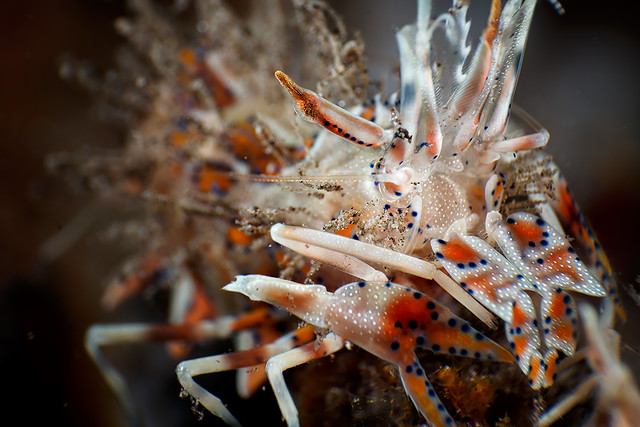
Photo credit:
”Ludovich.”CRINCH! #CrabOfTheDay for 10/24/2016: Phyllognathia ceratophthalma, or The Spiny Tiger Shrimp (Sometimes called the Bongo Shrimp) is a fascinating Indo-Pacific reef dweller named for both its extreme spikes, and its tiger-like carapace color. Infrequently found by divers, P. ceratophthalma can be witnessed in these instances hanging out on corals in pairs or small groups. Behaviorally cryptic, Spiny Tigers usually stay out of sight among algae, sponges, rubble, and broken coral – mostly in an encrusted mix of them all... This shrimp is not very common!
Photo credit: “Ludovich.”
http://www.marinespecies.org/aphia.php? ... &id=514433http://www.eol.org/pages/4262623/overview
Re: CRINCH! The Crab of the Day!
Posted: Wed Oct 26, 2016 12:33 am
by Nezumiiro

Photo credit:
J. Poupin & Cléva.CRINCH! #CrabOfTheDay for 10/25/2016: Polyonyx boucheti, or Bouchet's Crab is a tiny, oft-overlooked porcellanid crab, native to the Loyalty Islands in the south-western Pacific, and the Comoro Islands in the South-Western Indian Ocean. This benthic shallow reef crab is covered with delicate short striae on its entire carapace surface. Officially catalogued by rockstar Japanese Entomologist, Masayuki Osawa (Research Center for Coastal Lagoon Environments, Shimane University) in 2007- P. boucheti’s scientific name was dedicated to Dr. Philippe Bouchet of MNHN, who organized and was the head of a Lifou Island study.
http://www.marinespecies.org/aphia.php? ... &id=410136http://www.eol.org/pages/39159169/overview
Re: CRINCH! The Crab of the Day!
Posted: Wed Oct 26, 2016 11:19 pm
by Nezumiiro
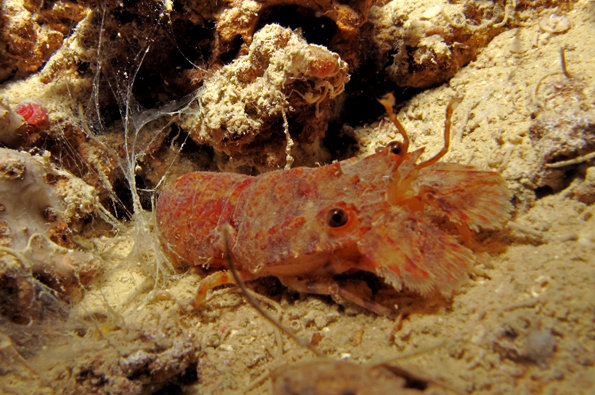
Photo credit:
Brian Azzopardi.CRINCH! #CrabOfTheDay for 10/26/2016: Scyllarus pygmaeus, or The Pygmy Locust Lobster (sometimes called the Mediterranean Slipper Lobster) is a craaaaaaazzzzyyy looking family Scyllaridae Decapod. As is the case with all Slipper Lobsters, the second antennae of S. pygmaeus is expanded and flattened into large plates that extend horizontally forward from the animal's head. This strange critter has a wide distribution in the Mediterranean Sea, Eastern Atlantic Islands, Madeira, the Canary Islands and the Cape Verde Islands. The smallest living variety of slipper lobster, (rarely larger than 40 mm or 1.6,”) this species was originally assumed to be the immature form of S. arctus.
Fun Fact: Slipper Lobsters grow slowly and live to a considerable age.
http://www.marinespecies.org/aphia.php? ... &id=107712http://species-identification.org/speci ... ers&id=203
Re: CRINCH! The Crab of the Day!
Posted: Fri Oct 28, 2016 1:16 am
by Nezumiiro
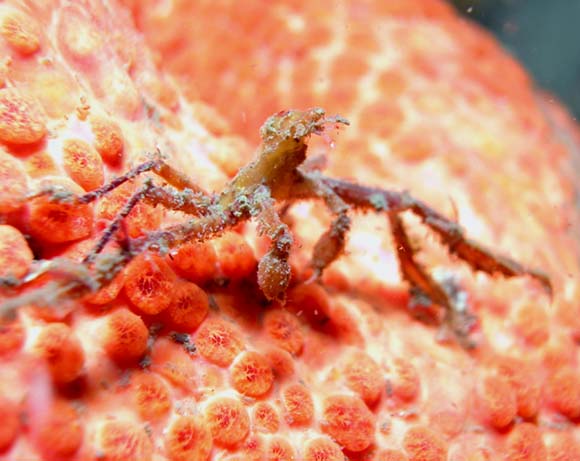
Photo credit:
Dave Harasti.CRINCH! #CrabOfTheDay for 10/27/2016: Oncinopus neptunus, or The Coral Orangutan Crab is a freaky family Inachidae Spider Crab, widespread in Indo-west Pacific, New Caledonian, Red Sea, and East African waters. A shallow (< 100 m) rubble dweller, O. neptunus lives an extremely symbiotic lifestyle with the corals it lives on; providing protection and cleaning services for the stable home it receives in return. In some cases though, cleaning is the gist of it, as stinging corals do the protecting! As is the case with all “Orangutan Crabs,” this beastie is shaggy with some ridiculous setae!
http://www.marinespecies.org/aphia.php? ... &id=217311http://eol.org/pages/312972/overview
Re: CRINCH! The Crab of the Day!
Posted: Fri Oct 28, 2016 11:38 pm
by Nezumiiro

Photo credit:
P. Bacchet.CRINCH! #CrabOfTheDay for 10/28/2016: Metopograpsus thukuhar, or The Estuarine Rock Crab is an Indo-Pacific species of diminutive mangrove crab. Though this family Grapsidae crab is extremely widely distributed, the largest concentrations can be found in the Mid-Pacific islands- namely Hawaii and Guam. In Hawaii, this species shares the name 'Alamihi' with its cousin, Metopograpsus messor, though both inhabit mangrove estuaries, living on and underneath the roots of Rhizophora mucronata (The Loop-root mangrove) and Ceriops tagal. (The Tengar) M. thukuhar can be easily ID’ed due to the fact that its chelipeds have a violet colored external face. Unfortunately, this rock crab is extremely prone to parasitization by the barnacle, Polyascus plana. GROSS!
http://www.marinespecies.org/aphia.php? ... &id=207537http://eol.org/pages/342748/details
Re: CRINCH! The Crab of the Day!
Posted: Sun Oct 30, 2016 11:22 am
by Nezumiiro
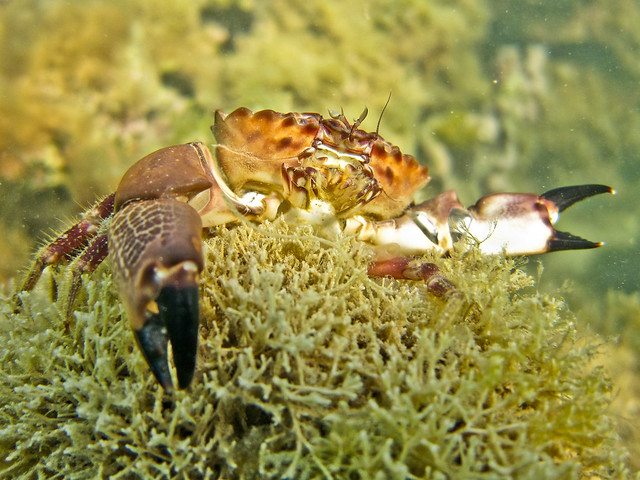
Photo credit:
JL Feitosa.CRINCH! #CrabOfTheDay for 10/29/2016: Menippe nodifrons, or The Cuban Stone Crab (Sometimes called the Lumpy Stone Crab) is a fantastic little nipper found in the tropical warm waters of the West Atlantic Ocean. This family Menippidae species is common in Brazil and Florida, but also pops up in the Antilles and parts of Central America. Tidepoolers such M. nodifrons as are said to be “epibenthic,” or predominantly inhabiting the area directly ‘on top. of the sea floor. These zones are ideal for opportunistic omnivores like the Cuban Stone Crab as they contain an abundance of polychaetes, algae, crabs and mollusks.
http://www.marinespecies.org/aphia.php? ... &id=241128http://eol.org/pages/1021197/overview
Re: CRINCH! The Crab of the Day!
Posted: Sun Oct 30, 2016 3:55 pm
by Nezumiiro

Photo credit:
Dr. Tom Bailey.CRINCH! #CrabOfTheDay for 10/30/2016: Metasesarma obesum, or the Batik Crab (Marble Crab also!) is an Indo-Pacific family Sesarmidae species, widely sold in the domestic aquarium market. This semi-terrestrial crab has a diverse salinity tolerance, and thus can be found in many marine, brackish, or freshwater environments. These diminutive crabs hide under leaves, driftwood, or dig small holes in sandy ground. Named for Batik dye textiles, M. obesum exhibits wide variations in color and pattern.
http://www.marinespecies.org/aphia.php? ... &id=246198http://www.eol.org/pages/2981531/overviewhttps://www.youtube.com/watch?v=oCNDmFGYht8
Re: CRINCH! The Crab of the Day!
Posted: Sun Oct 30, 2016 3:57 pm
by Nezumiiro

Photo credit:
"Madaeon."CRINCH! BONUS #CrabOfTheDay for 10/30/2016: Using some rather fun and inventive design utilizing a ‘LEMON JUICE BATTERY” the legs and claws of the crab are the battery terminals, used to make its LED eyes light up. To power this amazing bit of electronic fun, you merely squeeze a few drops of lemon juice on each leg and claw of the crab! This is a fairly safe and fun electronics project to do with kids as each cell only generates about 0,7 V.
http://www.instructables.com/id/The-mic ... emon-Crab/
























